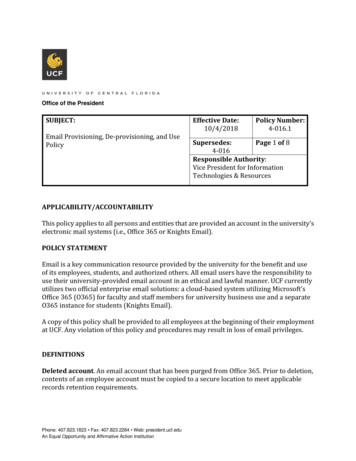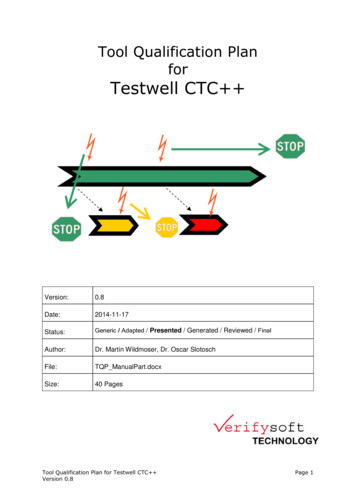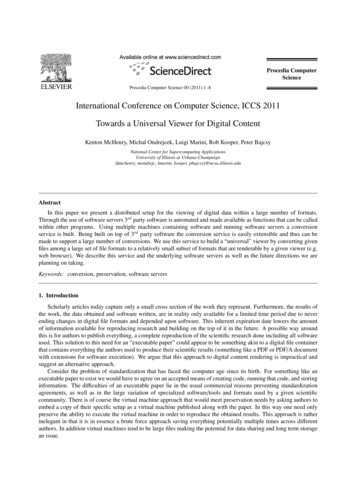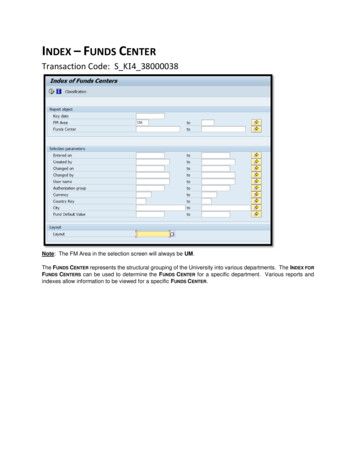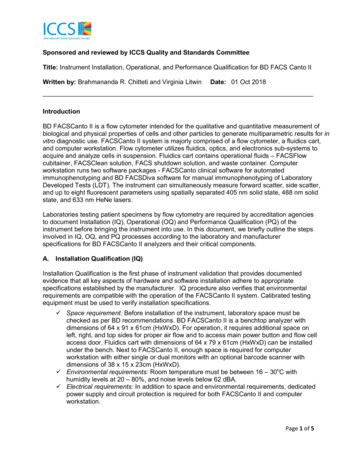
Transcription
Sponsored and reviewed by ICCS Quality and Standards CommitteeTitle: Instrument Installation, Operational, and Performance Qualification for BD FACS Canto IIWritten by: Brahmananda R. Chitteti and Virginia LitwinDate: 01 Oct 2018IntroductionBD FACSCanto II is a flow cytometer intended for the qualitative and quantitative measurement ofbiological and physical properties of cells and other particles to generate multiparametric results for invitro diagnostic use. FACSCanto II system is majorly comprised of a flow cytometer, a fluidics cart,and computer workstation. Flow cytometer utilizes fluidics, optics, and electronics sub-systems toacquire and analyze cells in suspension. Fluidics cart contains operational fluids – FACSFlowcubitainer, FACSClean solution, FACS shutdown solution, and waste container. Computerworkstation runs two software packages - FACSCanto clinical software for automatedimmunophenotyping and BD FACSDiva software for manual immunophenotyping of LaboratoryDeveloped Tests (LDT). The instrument can simultaneously measure forward scatter, side scatter,and up to eight fluorescent parameters using spatially separated 405 nm solid state, 488 nm solidstate, and 633 nm HeNe lasers.Laboratories testing patient specimens by flow cytometry are required by accreditation agenciesto document Installation (IQ), Operational (OQ) and Performance Qualification (PQ) of theinstrument before bringing the instrument into use. In this document, we briefly outline the stepsinvolved in IQ, OQ, and PQ processes according to the laboratory and manufacturerspecifications for BD FACSCanto II analyzers and their critical components.A.Installation Qualification (IQ)Installation Qualification is the first phase of instrument validation that provides documentedevidence that all key aspects of hardware and software installation adhere to appropriatespecifications established by the manufacturer. IQ procedure also verifies that environmentalrequirements are compatible with the operation of the FACSCanto II system. Calibrated testingequipment must be used to verify installation specifications. Space requirement: Before installation of the instrument, laboratory space must bechecked as per BD recommendations. BD FACSCanto II is a benchtop analyzer withdimensions of 64 x 91 x 61cm (HxWxD). For operation, it requires additional space onleft, right, and top sides for proper air flow and to access main power button and flow cellaccess door. Fluidics cart with dimensions of 64 x 79 x 61cm (HxWxD) can be installedunder the bench. Next to FACSCanto II, enough space is required for computerworkstation with either single or dual monitors with an optional barcode scanner withdimensions of 38 x 15 x 23cm (HxWxD). Environmental requirements: Room temperature must be between 16 – 30oC withhumidity levels at 20 – 80%, and noise levels below 62 dBA. Electrical requirements: In addition to space and environmental requirements, dedicatedpower supply and circuit protection is required for both FACSCanto II and computerworkstation.Page 1 of 5
For physical installation, all components must be verified for any damage. Installationcomponents includeFACSCanto II cytometer with appropriate laser and PMT options, fluidics cart, computerworkstation with appropriate versions of BD FACSDiva and BD FACSCanto clinical software,optional FACS Loader, and optional BD HTS. For all components installed, notes should betaken for their physical integrity and if they power up upon connection. Test parameters meetingthe specified criteria will be indicated with “Pass”, and parameters not meeting criteria will beindicated with “Fail”. If any deviations are observed, the executor will complete an exceptionreport including corrective action taken. Installation qualification results and actual readings arefurther reviewed by instrument validation team to verify if each result is acceptable. Validationteam also ensures the proper documentation of reports and screenshots with positive notationof pass/fail/error messages, and executor’s initials and date to meet all regulatory requirements.B.Operational Qualification (OQ)OQ protocol provides documented evidence that the FACSCanto II system functions within thespecified operating ranges set by the manufacturer. OQ procedure also verifies theenvironmental requirements are compatible with the operation of FACSCanto II system.Calibrated testing equipment must be used to verify OQ testing. OQ testing parameters include: Software Operation: Verify FACSDiva and FACSCanto clinical software executessuccessfully with no error messages, and connects to the instrument. Fluidics Startup: Fill BD FACSFlow sheath fluid, BD FACSClean solution, and BD FACSShutdown solution in appropriate tanks and make sure there are no leaks, sheath andwaste level detectors are operational, and system is primed when the option is selectedin the software. Make sure fluidics cart air pressure and auxiliary air pressure are atmanufacturer’s recommendation. Sample Flow Rate: Determine sample flow rate by measuring the volume of fluidconsumed in 5 minutes at low, medium, and high speeds and make sure BDrecommended flow rate is achieved at each speed. Laser power: After 20 minutes of warmup, measure laser power for 488nm, 633nm, and405nm lasers using a calibrated laser power meter and make sure each laser yields themanufacturer recommended output. Digital PMT Voltage control: For each parameter, on a histogram, verify the movementof mean population to a different channel as voltage increased or decreased. Fluorescence Sensitivity: Sensitivity measures how well the dim populations areresolved from background. Using BD FACS 7-color setup beads, measure the sensitivityof each fluorescence detector and verify obtained sensitivity is greater thanmanufacturer specified value. Optical Precision: Optical precision is the relative standard deviation of a signalproduced by identical cells or particles. Using cytometer alignment beads withpredetermined coefficient variation (%CV), measure the %CV for each parameterincluding FSC and SSC and verify the obtained values are less than manufacturerspecified value. BD FACSLoader: If BD FACSLoader is installed, verify FACSCanto II identifies correctcarousal rack number and appropriate tube numbers in the rack. Also make sure all 40tubes are lifted and acquired without any error messages. BD HTS operation: If BD HTS is installed, verify BD HTS communicates with cytometerand FACSDiva software without error messages.Page 2 of 5
Bar code reader: If Bar code reader is installed, scan a specimen barcode ID on samplecollection tube and verify specimen number matches with the scanned number. CS&T Performance check: Using a specified lot of CS&T beads, run the CS&T baselinefollowed by CS&T performance and ensure instrument completes these runs withouterrors. System alerts: Make sure system alerts the user with appropriate warnings of fluidlevels, DAQ warnings, carousal rack ID and missing tube warnings, and run completealerts. Fluidics Shutdown: Run the fluidics shutdown and ensure the system executes theprocedure successfully without errors.Operational qualification can be performed by vendor (BD), qualified internal staff, or contractedexternal consultants. In our case, IQ and OQ were performed by BD, and internal validationteam further reviewed testing parameters if each result is acceptable. Validation team alsoensures the proper documentation of reports and screenshots with positive notation ofpass/fail/error messages, and executor’s initials and date to meet all regulatory requirements.C.Performance Qualification (PQ)PQ protocol provides documented evidence that system performs consistently over the periodof time for the intended purpose. This is the most time consuming part of the overall validation.PQ should be performed by qualified technologists in the lab. Basic PQ includes InstrumentPerformance through integrated QC applications, and monitoring linearity and sensitivity over aperiod of time. Extended PQ includes Inter-instrument comparison, Inter-laboratory comparison,and longitudinal performance. Instrument maintenance and performance: Daily maintenance of the cytometer includesrunning CS&T maintenance module with appropriate lot of beads on DIVA software andrunning BD FACS 7-color setup beads on FACSCanto clinical software. Review thecytometer report and ensure the run is passed without any error messages or warnings.CS&T baseline report and daily performance report from BD FACSCanto II provides upto 30 metrics about performance of the cytometer including – Linearity, Voltagedifference from previous run (delta PMTV), Electronic noise (SDen), optical background(Br), fluorescence detection efficiency (Qr), and %robust CVs for beads in graphicalform. Reports also list the laser power and current. If any of the parameters fail to meetthe criteria, save the report, and proceed with appropriate troubleshooting. Complete thedaily maintenance log with appropriate printouts and screenshots of errors/warnings.After testing is done, run cleaning cycles with appropriate reagents, and shutdownfluidics and cytometer. Weekly maintenance of the cytometer includes instrumentsurface cleaning, purging fluidic filters, emptying condensation trap, and completing themaintenance log. Monthly maintenance includes performing long clean of the cytometer,cleaning sensors, changing waster container caps, and reviewing Levey-Jenningsreports from CS&T and 7-color setup beads. Preventive maintenance is performedbiannually by BD service engineer. Inter-instrument comparison: Implementing standard operating procedures (SOP) forinstrument setup and assay setup and using standardized acquisition and analysistemplates reduces variability from instrument to instrument. Inter-instrumentperformance is evaluated by running the same sample, in parallel, on multipleinstruments followed by verifying %CV of results from instruments are within thePage 3 of 5
established or acceptable range. Acceptance criteria are established during validationand can be regularly reassessed. Inter-Laboratory comparison: Global testing of clinical samples on multiple instrumentsat various sites requires standardized instruments that perform similarly acrossinvestigation sites. Application settings based instrument standardization can beimplemented by setting target fluorescence values using hard dyed beads such asCS&T beads, 8 peak rainbow beads or Cyto-Cal or Fluorescent Control (FC) beads.Processes aimed at minimizing data variability across instruments and sites can includeestablishing acceptable ranges for each analyte with quality control (QC) reagents suchas stabilized human blood or lyophilized cells, and running QC reagents along withtesting specimen with each run. In order for the run acceptance, the QC results shouldbe within the established ranges. Periodically, specimens are split and ship acrosstesting sites and test results should be statistically comparable. To further reducevariability in assay performance, reagents titration and qualification can be performed atone site and distributed across testing sites. New lots of reagents must be evaluated toensure comparability. Also, cross-train technologists across sites to harmonize practices. Longitudinal Performance: Clinical trials are usually conducted over years. In order tomaintain quality performance over the time, establish protocols to monitor medianfluorescence intensity, linearity, and sensitivity for each fluorescence parameter usingcalibrated beads (Ex. CS&T beads (BD), Cyto-Cal beads (Thermo), rainbowcalibration particles (Spherotech), FC beads (BD)). Run these beads on a regular basis(daily, weekly or monthly according to the preferences of the user), and assessinstrument performance longitudinally.Quality control data from the instrument is monitored and reviewed on daily basis to ensureconsistency of instrument performance. Proper documentation of reports and screenshots withpositive notation of pass/fail/error messages, and executor’s initials and date is maintained.References:1. BD FACSCanto II Instructions For Use, Part No. 642239 Rev. A. June 20072. BD FACSCanto II technical specifications, 23-10918-003. BD FACSCanto II service documentation4. Litwin V, Green C. 2013. The role of biomarkers in clinical trials and the fit-for-purpose method validation . Green CL, Brown L, Stewart JJ, Xu Y, Litwin V, Mc Closkey TW. “Recommendations for the validation of flow cytometric testing duringdrug development: I instrumentation”. J Immunol Methods. 2011 Jan 5;363(2):104-19.6. O'Hara DM, Xu Y, Liang Z, Reddy MP, Wu DY, Litwin V. “Recommendations for the validation of flow cytometric testing during drugdevelopment: II assays”. J Immunol Methods. 2011 Jan 5;363(2):120-34.7. Meinelt E, Reunanen M., Edinger M., Jaimes M., Standardizing Application Setup Across Multiple Flow Cytometers Using BDFACSDiva Version 6 Software. (2012) www.bdbiosciences.com/documents/BD FACSDiva Stndrd App Setup TechBulletin.pdf.8. Hoffman RA, Wang L, Bigos M, Nolan JP. NIST/ISAC standardization study: variability in assignment of intensity values tofluorescence standard beads and in cross calibration of standard beads to hard dyed beads. Cytometry A. 2012;81:785-796.9. Yan M, Edinger MG, Zhu L, Crowther E, Sharkey M, Jaimes MC, Rogers T. A comparison of stable fluorochrome-specific beads andhard-dyed beads for standardized quantitative flow cytometer setup. Poster B221 Cyto/ISAC 2014.10. Kalina T, Flores-Montero J, Lecrevisse Q, Pedreira CE, van der Velden VH, Novakova M, Mejstrikova E, Hrusak O, Böttcher S, Karsch D,Sędek Ł, Trinquand A, Boeckx N, Caetano J, Asnafi V, Lucio P, Lima M, Helena Santos A, Bonaccorso P, van der Sluijs-Gelling AJ,Langerak AW, Martin-Ayuso M, Szczepański T, van Dongen JJ, Orfao A. Quality assessment program for EuroFlow protocols:summary results of four-year (2010-2013) quality assurance rounds. Cytometry A. 2015 Feb;87(A):145-56.11. Kalina T, Flores-Montero J, van der Velden VH, Martin-Ayuso M, Böttcher S, Ritgen M, Almeida J, Lhermitte L, Asnafi V, Mendonça A,de Tute R, Cullen M, Sedek L, Vidriales MB, Pérez JJ, te Marvelde JG, Mejstrikova E, Hrusak O, Szczepański T, van Dongen JJ, Orfao A;EuroFlow standardization of flow cytometer instrument settings and immunophenotyping protocols. Leukemia. 2012Sep;26(9):1986-2010.12. Perfetto SP, Chattopadhyay PK, Wood J, Nguyen R, Ambrozak D, Hill JP, Roederer M. Q and B values are critical measurementsrequired for inter-instrument standardization and development of multicolor flow cytometry staining panels. Cytometry A. 201485(12):1037-48.Page 4 of 5
13. Perfetto SP, Ambrozak D, Nguyen R, Chattopadhyay P, Roederer M. Quality assurance for polychromatic flow cytometry. Nat Protoc.2006;1(3):1522-30.14. Perfetto SP, Ambrozak D, Nguyen R, Chattopadhyay PK, Roederer M. Quality assurance for polychromatic flow cytometry using asuite of calibration beads. Nat Protoc. 2012 Dec;7(12):2067-79.Reviewed and approved by:1. Teri Oldaker, independent consultant2. Laura Johnson, Mayo Clinic PhoenixFor any questions on this module or any other suggestions, please email info@cytometry.orgThe documents posted on ICCS website may contain product or vendor names which are provided for platform specific guidance. Anyreference within the ICCS Quality and Standards modules to any vendor, product or educational material by trade name, trademark ormanufacturer does not constitute or imply the endorsement or recommendation by ICCS.Page 5 of 5
bd facscanto ii is a flow cytometer intended for the qualitative and quantitative measurement of biological and physical properties of cells and other particles to generate multiparametric results for in vitro diagnostic use. facscanto ii system is majorly comprised of a flow cytometer, a fluidics cart, and computer workstation. flow cytometer


